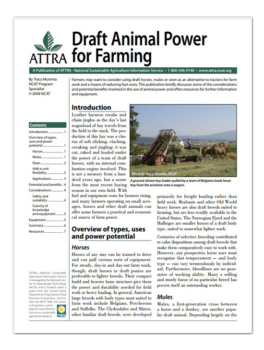Draft Animal Power for Farming
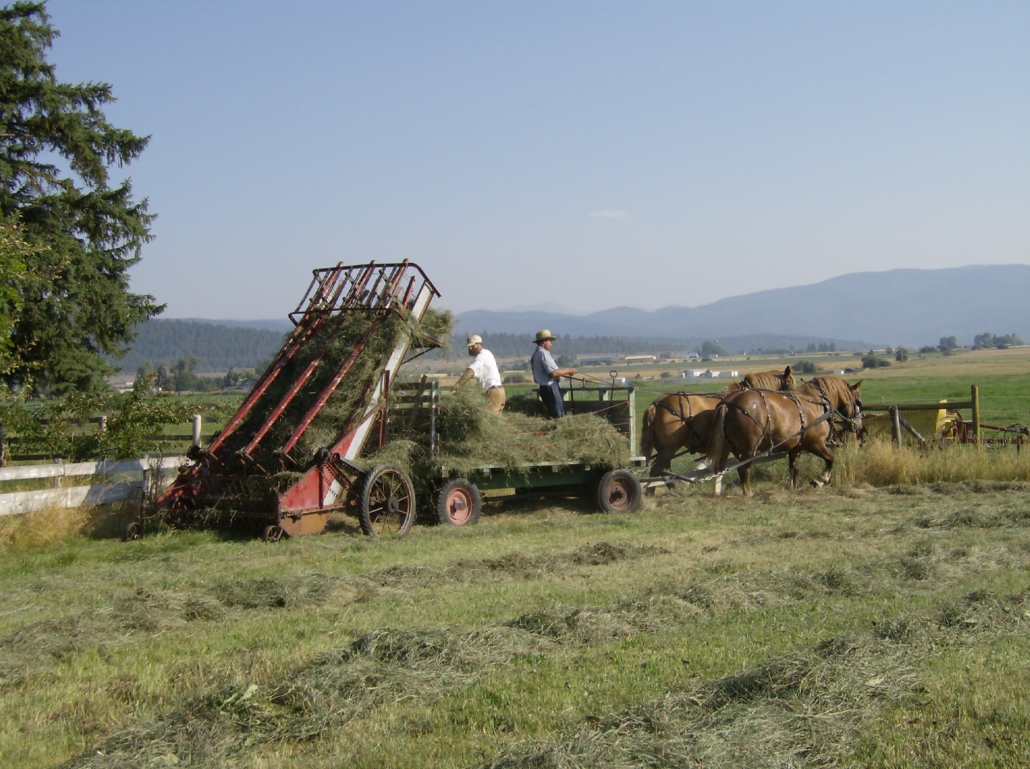
A ground-driven hay loader pulled by a team of Belgians loads loose hay from the windrow onto a wagon.
By Tracy Mumma, NCAT Program Specialist
Abstract
Farmers may want to consider using draft horses, mules, or oxen as an alternative to tractors for farm work and a means of reducing fuel costs. This publication briefly discusses some of the considerations and potential benefits involved in the use of animal power and offers resources for further information and equipment.
Contents
Introduction
Overview of Types, Uses, and Power Potential
Potential and Benefits
Considerations
Equipment
Summary
Further Resources
Introduction
Leather harness creaks and chain jingles as the day’s last wagonload of hay travels from the field to the stack. The production of this hay was a chorus of soft clicking, clacking, creaking and jingling: it was cut, raked and loaded under the power of a team of draft horses, with no internal combustion engine involved. This is not a memory from a hundred years ago, but a scene from the most recent haying season in our own field. With fuel and equipment costs for farmers rising, and many farmers operating on small acreages, horses and other draft animals can offer some farmers a practical and economical source of farm power.
Overview of Types, Uses, and Power Potential
Horses
Horses of any size can be trained to drive and can pull various sorts of equipment. For steady, day-in and day-out farm work, though, draft horses or draft ponies are preferable to lighter breeds. Their compact build and heavier bone structure give them the power and durability needed for field work or heavy hauling. In general, American large breeds with body types most suited to farm work include Belgians, Percherons and Suffolks. The Clydesdales and Shires, other familiar draft breeds, were developed primarily for freight hauling rather than field work. Brabants and other Old World heavy horses are also draft breeds suited to farming, but are less readily available in the United States. The Norwegian Fjord and the Haflinger are smaller horses of a draft body type, suited to somewhat lighter work.
Centuries of selective breeding contributed to calm dispositions among draft breeds that make them comparatively easy to work with. However, any prospective horse user must recognize that temperament – and body type – can vary tremendously by individual. Furthermore, bloodlines are no guarantee of working ability. Many a willing and sturdy horse of no particular breed has proven itself an outstanding worker.
Farming draft horse characteristics
| Common weights | 1,400 – 2,100 pounds |
| Typical shoe size | 5 to 8 |
| Desirable temperament | Calm and willing |
| Desirable bone structure | Thick neck, wide chest, sturdy legs |
| Reaches full adult size and weight | Age 5 |
| Potential working lifespan | Approximately 15 years; ages 3-18 |
Mules
Mules, a first-generation cross between a horse and a donkey, are another popular draft animal. Depending largely on the heritage of their horse parent, mules come in all shapes and sizes. Finding mules with the bone structure and build for heavy work may be a challenge in some parts of the country, where riding mules are more popular than draft mules.
Mules are known for their hardiness and strength. They have a strong sense of self-preservation that prevents them from overworking, overeating or foundering, but can make it difficult to convince them to use their strength on your behalf. Apart from their mindsets, hoof size and shape and harness fit, the differences between horses and mules in terms of draft power are slight. Throughout the remainder of this publication, “horses” may be taken to mean either horses or mules.
Is one horse a horsepower?
The term “horsepower” is somewhat misleading, since an individual horse can actually deliver up to 27 horsepower in short bursts of power with instant maximum torque. For sustained, hour-after-hour work, horsepower output will, of course, be lower. Different farm jobs require different amounts and types of power, depending on the equipment being used and the soil conditions. For example, the power needed for tillage is directly related to soil conditions and implement size and design. How much weight a horse can pull is heavily dependent upon the following conditions:
- Is the animal in shape?
- Is it tired from a day of work?
- Is the load on wheels or being skidded along the ground?
- Does the harness fit properly?
- Is the equipment in good working order?
It’s not unusual for a horse in working shape to be able to pull a load equal to its own weight along the ground-but not for a whole day.
Oxen
Cattle trained as draft animals are called oxen. Theoretically any calf could be trained as a draft animal, though draft steers are by far the most common. Dairy and mixed-use breeds are more often used as oxen than beef breeds, perhaps because male dairy calves are comparatively inexpensive. Calves that will be used as oxen should be socialized to people as soon as possible after birth, and training can begin when the calves are just a few months old. Their pulling power is obviously limited until full growth is attained.
A fully grown ox can easily outweigh a draft horse and can pull more weight. Oxen travel more slowly than horses and may be less suited to some applications. In contrast to horse harness, in which the animal’s pulling power comes from the chest region and the animal is controlled by means of a bit in its mouth, oxen in the United States typically wear a yoke that transfers pulling power from their neck region and the driver steers them by tapping them on the side, with voice commands or by using a rope around the horns. Unless the oxen are very responsive, it may be difficult to achieve the precision directional control needed for applications such as cultivation.
A common yoke setup for oxen is generally far less expensive than harness for horses and may even be home fabricated. Oxen are most often worked as a team, in part because the presence of another animal tends to have a calming effect.
Add-a-Unit Flexibility
Draft animals offer a unique flexibility in farm work. If you find you need more horsepower to accomplish what you need to do on a daily basis, it’s comparatively simple to add another power unit. Horses may be worked single or in a hitch. Horses are commonly worked as a team, which tends to create a synergy that lets them accomplish more work. By modifying hitch and harness arrangements, it’s fairly easy to add a third or fourth power unit. It’s theoretically possible to go on increasing the hitch size nearly infinitely, but the power advantage is rapidly diminished by reduced maneuverability and control, not to mention cost. Though 50-horse hitches were not unheard of in days before tractors became common in Western wheat-producing regions, today large hitches are more of a publicity stunt than a practical power source. A working hitch of four horses is common. A hitch of six is less common, but not unusual. Larger working hitches are rare enough to be newsworthy.
Horses can be hitched either in teams of two with one in front of the other—this is referred to as “up,” as in a four-up or six-up hitch—or side by side, which is called “abreast” as in a four-abreast or six-abreast. An up hitch requires the driver to have a set of lines for each team, which rapidly becomes a confusing tangle of leather in the driver’s hands. Alternatively, an abreast hitch of more than four may be too wide to move through gates and too wide to turn easily for field work.
A small-scale operation such as a market garden might need just one or two horses for the full range of work. A larger row-crop or small field-crop operation might use two or three horses. Mid-size field crop operations that use tractor-adapted machinery may need four or more horses in order to perform most jobs. Alternatively, any operation might consider using just a single team for lighter fieldwork and saving the tractor for the heaviest work.
Applications
Despite what skeptics may say, draft animals can perform a full range of farm duties. After all, draft animals were the primary motive power on most farms for centuries before tractors replaced them. But farming with animals doesn’t necessarily mean a return to the technologies and working conditions of centuries ago. Many horse farmers use cutting-edge technologies and implements. A forecart, or even a power forecart, pulled by draft animals can provide the means for using many smaller-scale modern farm implements right off the shelf.

Forecarts like these manufactured by Pioneer Equipment can help farmers use many different types of implements with draft horse power. Photo: Tracy Mumma, NCAT
Like tractors, draft animals can provide the motive power for preparing seed beds, planting and cultivating row crops. They may also be used for preparing fields, planting, cultivating and harvesting agronomic or field crops. Draft animals can provide power for cutting, raking and baling or loose-stacking hay. They may also be used for pasture seeding and clipping.
Draft animals are used on many livestock operations for hauling or distributing feed. They can play an on-farm transportation role for feed, harvested produce or building supplies. They can provide motive power for mobile poultry coops, hog pens and sheep or calf shelters. Landowners with woodlots may use draft animal power for moving firewood or hauling logs for construction or sale.
Some farmers and ranchers have found that adding draft animals to their operations opens a profitable agritourism opportunity. For example, pairing hayrides with U-pick Halloween pumpkins, flowers, apples or other produce can draw many additional customers.
On some operations, draft animals could provide power for processing operations such as oilseed, olive or grape crushing, grain separation or other tasks. A piece of equipment called a “horsepower” uses draft animal power to generate electricity. The equipment for powering operations like these with animals can be difficult to obtain in the United States. Unless you plan to design, build and maintain the specialized equipment yourself, processing and generating probably aren’t the most practical applications for draft animals. On the other hand, animal-powered processing is a unique niche that’s almost sure to draw a crowd’s attention to your operation.
Potential and Benefits
Draft animals can offer farmers the advantage of a low initial investment in farm motive power compared to the purchase of even a relatively small tractor. A prospective horse farmer can spend a great deal of money on registered stock, harness and equipment. But it’s also possible to obtain perfectly serviceable trained animals, used harness and functional equipment at reasonable prices. If saving money by using draft animals is your motivation, you may be able to do so. Just don’t cut corners on safety in the interest of cutting cost. For a novice operator, a well-trained animal is well worth the cost. Sturdy, complete harness is vital.
One advantage of using draft animals as farm power is that their fuel can all be generated on-farm. Opinions vary on whether working horses should be fed grass or alfalfa hay and supplemented with oats or corn. The point is that all of these feeds can be produced locally, if not on the farm itself. Unlike a tractor, draft animals fit in to the nutrient cycle of a farm, utilizing local inputs and providing an output of power with a fertilizer byproduct.
Draft animals can be exceptionally flexible in application. For example, the same team of horses can plow and plant in spring, cultivate in summer, haul in the fall harvest of crops and firewood and feed livestock and offer sleighrides in winter. Once the team is in harness, it’s as efficient to use them for a little task as a big one since they’re not burning any more fuel. Maneuverable horses can turn within their own length and they’re a power unit that easily moves from one task to another and one place to another.
In the long view, some draft animals are even capable of producing their own replacements in the form of offspring, something no piece of machinery can do. However, even an enthusiast does well to consider that breeding and training animals are entirely different propositions from working with already trained stock.
The chief benefit of working with draft animals may be their sheer appeal. Some farmers find it especially fulfilling to work daily with a human-scale, living and breathing partner rather than a machine. And draft animals at work have a traffic-stopping appeal for the public that can build farm brand recognition and consumer loyalty more effectively than any paid advertising.
Considerations
Safety and Suitability
Not every steer is suited by temperament to be an ox and not every horse is suited to work in harness. Similarly, not every farm worker is suited by temperament to be a teamster. If either the animal or the handler is forced into the job, the potential for accident and injury to both increases exponentially. The best results are achieved by teamsters who are using draft animals because they want to, not because they feel they have to. And the best production is achieved by animals that are willing to work and not spending more energy fighting the handler than doing the job.
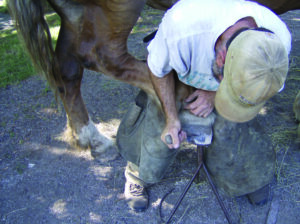
Working horses require hoof care every eight weeks on average and may need shoes depending on the type of work and the terrain. Finding professionals accustomed to serving the health needs of draft animals can be unexpectedly challenging. Photo: Tracy Mumma, NCAT
Some people who use draft animals joke that their motivation is that “they start every time, unlike my tractor.” It’s true that draft animals perform well even in cold weather, when machinery is hard to start. But it’s vital to remember that an animal, unlike a machine, has maintenance needs even when it’s not being used. Though the inputs required may be comparatively low in cost, draft animals will need to be fed and watered all year long. It comes as a surprise to some people that a working draft horse consumes considerably more feed than a pastured riding horse. Furthermore, horses and other working animals need regular foot care, veterinary care and properly fitted harness. And, like any high-performance athlete, draft animals need conditioning if they’re going to provide peak output for any length of time.
Unlike a tractor, a draft animal may not come out of its winter “storage” in the same condition you put it away. It may need some re-training, or at least a refresher in obeying the driver’s commands. An animal that has been pastured for months will need to ease in to a work routine to tone muscles before it’s ready for a full day of field work. Working animals regularly throughout the year helps minimize these potential problems. Ideally draft animals will have some kind of work to do year-round, rather than just seasonally, to keep them mentally and physically fit.
In any day of working with animals, it’s important to recognize that they’re not machines. Animals need to warm up in the morning or after a long break to avoid injury when they tackle a hard job. They need rest breaks when they’re doing a hard job and breaks for feed and water. And animals can be unpredictable. There are days when even the best-trained animal feels cranky and is a challenge to work with.
Draft animals can be extremely versatile and they can accomplish a great deal of work. But they are slower than large farm equipment. If you’re used to working at a high speed with power equipment, working with animals will require a different mindset. If you have a large-scale or single-crop operation with a critical short time window for planting, cultivating or harvesting, draft animal power may not be a good match for your needs. If, on the other hand, you have a small-scale or very diverse operation with power needs spread throughout the growing season – or better yet, throughout the year – draft animals may fit in well.

A team of Belgians pull a restored antique sickle bar mower. Photo: Tracy Mumma, NCAT
Scarcity of Knowledge and Equipment
One of the challenges farmers face in putting draft animals to work today is a lack of general knowledge about farming with animals and a lack of equipment designed for use with animal power. In most communities in the United States there is a knowledge gap of generations. Few people have direct experience in farming with horses and if you run into difficulties you can’t call the dealer for advice or take your team in to the nearest mechanic for a tune up. Fortunately for beginners, there are courses on driving draft animals – some specific to farm applications – offered in many parts of the country. Some of these are listed in the Resources section of this publication. It’s well worth learning tricks of the trade from someone with experience, whether in a formal course or with a personal mentor. Inexperienced animals and an inexperienced driver can be a dangerous combination, particularly when farm equipment is involved.
Even more-experienced farmers frequently face challenges finding and using appropriate animals and equipment. Some of the resources listed at the end of the publication are invaluable when local knowledge or help is unavailable.
Equipment
After obtaining the animals, the next challenge the prospective draft animal farmer faces is finding equipment. Both leather harness and various synthetic options for horses and mules are readily available by mail order nationwide. Periodicals in the Resources section below list and advertise numerous suppliers. Used harness is also frequently available. However, used harness isn’t always a bargain and may pose a very real safety risk if the leather has been weakened by poor maintenance or decades of storage in marginal conditions. Many wrecks and runaways have been caused by inadequate harness that failed at an inopportune moment and could have been avoided by testing strap strength, maintaining leather and replacing worn hardware.
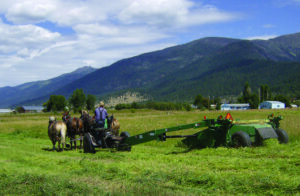
Belgians four abreast pull a power forecart and modern tractor-adapted mower. Photo: Tracy Mumma, NCAT
People who want to farm with animals have three options when it comes to finding farm equipment:
- Restored or preserved antiques
- New innovations for draft animal farming
- Adaptations of tractor-based equipment
Finding workable antique horsedrawn equipment from an ever-shrinking pool is increasingly challenging everywhere and a special challenge in locations without a recent horse-farming history. Once antique equipment is obtained, there’s usually another challenge in restoring it to working order. Fortunately owner’s manuals for many pieces of equipment are available, either as reprints from specialty publishers, online from collectors or in some cases from the archives of the original manufacturer. Surprisingly, some manufacturers still offer replacement parts for horsedrawn farm implements they haven’t manufactured for decades. There are also businesses that specialize in either used or newly manufactured replacement parts for popular models of horsedrawn equipment.
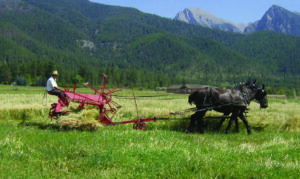
A team of Percheron horses pulls a working antique grain binder in a field of oats. Photo: Tracy Mumma, NCAT
In recent years the growing scarcity of antique horsedrawn equipment has led a few companies into the manufacture of new farm equipment designed specifically for use with animal power. While this new equipment has a higher up-front cost than derelict – or even working-order – antique equipment, it often offers design features that improve safety and performance, such as disc brakes or shear pins. Some major equipment manufacturers are listed in the Further Resources section.
Resourceful teamsters have also found success in adapting equipment designed for tractors for use with animals. Forecarts offer the teamster a place to ride and provide a hitch for three-point or drawbar implements. Power forecarts, also called powercarts, have an engine used to power implements that would ordinarily be powered by a tractor’s power take-off. With a forecart, many tractor-designed implements will work with animal motive power. A few considerations are key:
- The scale of the implement relative to the number of animals that will pull it and the land area to be covered.
- The point of balance when the implement is under load. Does it excessively weigh down the animal’s neck?
- The minimum operating speed required for the implement. Animals can move quickly, but they do tire and their speed may not be as steady as the speed of machinery over uneven terrain or while cornering.
Back to top
Summary
A farmer with patience, flexibility and ingenuity may find that draft animals fit well into the farming operation and offer the means to save on some fuel and equipment costs and to meet farm power needs with on-farm inputs. Working with horses or oxen as farm motive power offers unique rewards along with particular challenges.
Further Resources
Publications, Organizations, and Annual Events
Rural Heritage
P.O. Box 2067
Cedar Rapids, IA 52406
Rural Heritage publishes a bimonthly journal in support of small farmers and loggers who use draft horse, mule and ox power. Back issues are indexed online, with the current issue and numerous other resources also available online.
Small Farmer’s Journal
P.O. Box 1627
Sisters, OR 97759-1627
800-876-2893
541-549-2064
This publishing company offers Small Farmer’s Journal, a quarterly publication on all aspects of small, independent farming. In addition, they publish several books by Lynn Miller on training and using workhorses for farming, with titles such as The Workhorse Handbook; Training Horses, Training Teamsters; Haying with Horses; Horsedrawn Plows and Plowing; and Horsedrawn Tillage Tools. For the past several years, Small Farmer’s Journal has sponsored an auction and swap meet of horsedrawn equipment and animals, held in April in Sisters, Ore.
Tillers International
10515 East OP Avenue
Scotts, MI 49088
800-498-2700
269-626-0223
Tillers International seeks to preserve, study and exchange low-capital technologies that increase the sustainability and productivity of people in rural communities worldwide. They offer courses, publications and equipment for using animal power and technologies, including both horses and oxen.
Horse Progress Days
Horse Progress Days is the annual showcase event for newly manufactured and modified horsedrawn equipment. The annual multi-day event is held in a different location each year and usually features field demonstrations, exhibits, educational seminars and other related activities.
Oxen: a Teamsters Guide. By Drew Conroy Storey Publishing, LLC ISBN: 978-1580176927
A well-respected, revised edition of the classic ox-training manual.
The Draft Horse Primer: A Guide to the Care and Use of Work Horses and Mules. By Maurice Telleen. Rodale Press, 1977.
ISBN O-87857-161-2.
A well-known classic in the field of draft horses.
Permanent Farming Systems Based on Animal Traction: Farmers Handbook. By Rene Fischer. 1995.
This 183-page guide was published in 1995 and serves as a reference for people involved in agriculture in West Africa. It contains sections on draft cattle and donkeys, as well as draft animal implements and how they are used in an agricultural system. Each chapter is online as a separate document.
Selected Modern Equipment Manufacturers
Pioneer Equipment Inc.
16875 Jericho Road
Dalton, OH 44618
(330) 857-6340
(330) 857-0296 FAX
Manufactures a broad line of horsedrawn wagons, forecarts, PTO carts, harrows, plows and eveners. Available from a network of local dealers or from the manufacturer.
I & J Manufacturing
5302 Amish Road
Gap, PA 17527
(717) 442-9451
(717) 442-8305 FAX
Manufactures forecarts, including power and ground-drive models. Also offers horsedrawn plows and a range of three-point attachments for carts, such as harrow, rototiller, and mower.
Harness
You may be fortunate enough to have a local harness maker or at least a harness dealer in your area. It’s worth checking your local phone book. A conveniently located harness maker is often a teamster’s best friend for a quick repair when breakdowns occur or modifications are needed to accommodate a new piece of machinery or a new animal. If you can’t find a local source of harness, there are companies that serve a national market by mail order, including:
Midwest Leather Co.
81202 Highway 70
Beckwourth, CA 96129
(888) 211-3047
Bowman Harness
6928 County Road 77
Millersburg, OH 44654
(330) 763-5108
Brodhead Collar
Bloomfield, IA
(641) 722-5222
Draft Animal Power for Farming
By Tracy Mumma
NCAT Program Specialist
© NCAT
IP335
This publication is produced by the National Center for Appropriate Technology through the ATTRA Sustainable Agriculture program, under a cooperative agreement with USDA Rural Development. ATTRA.NCAT.ORG

